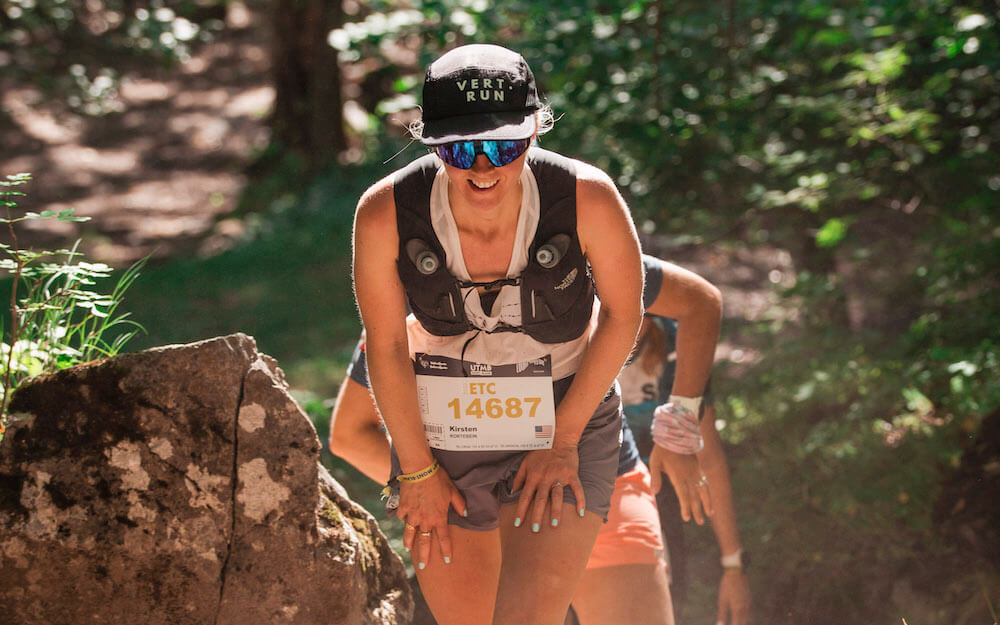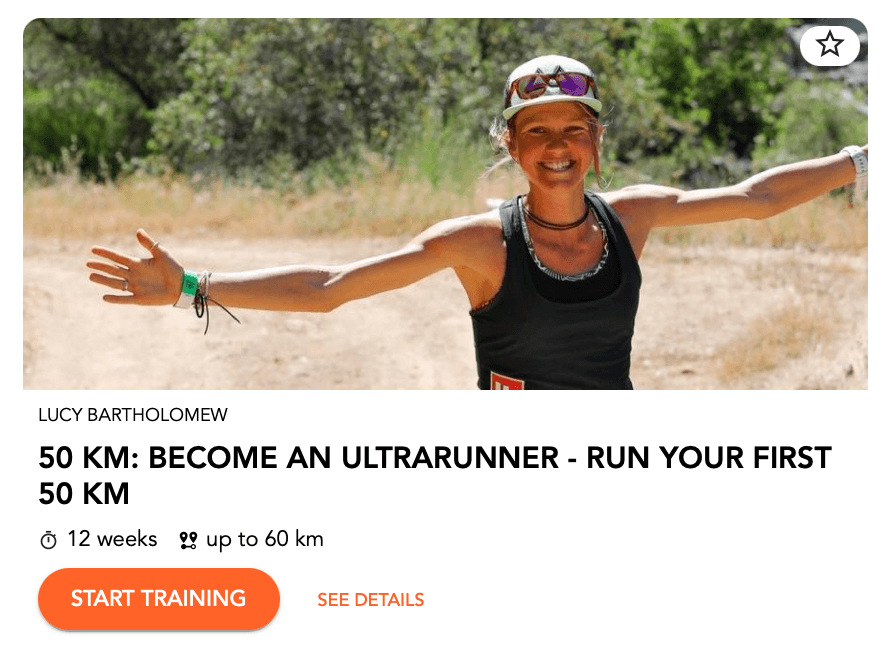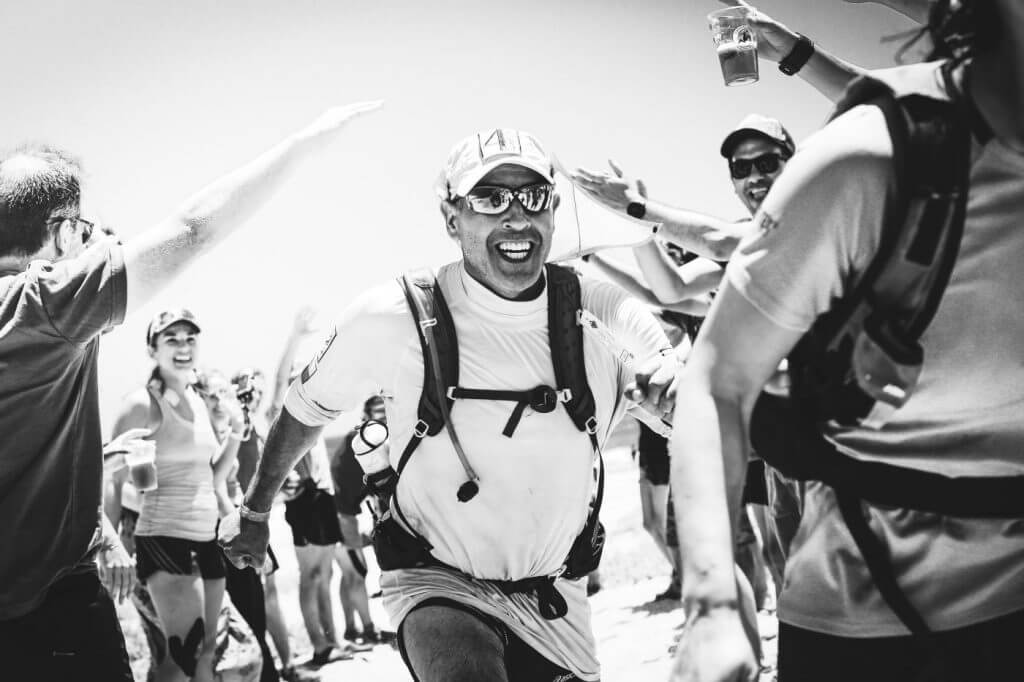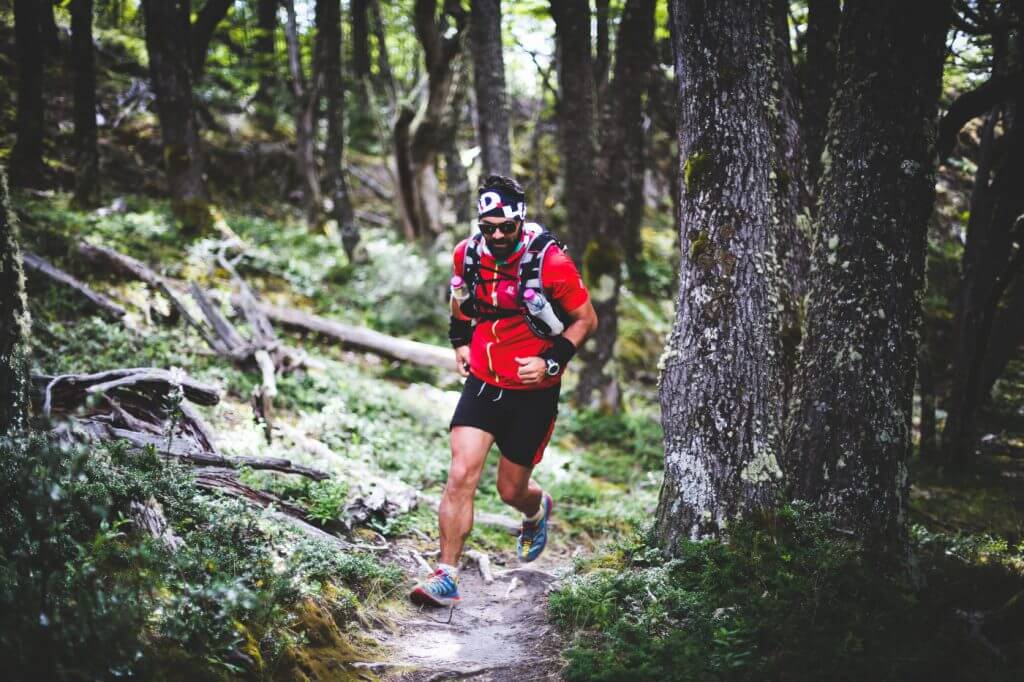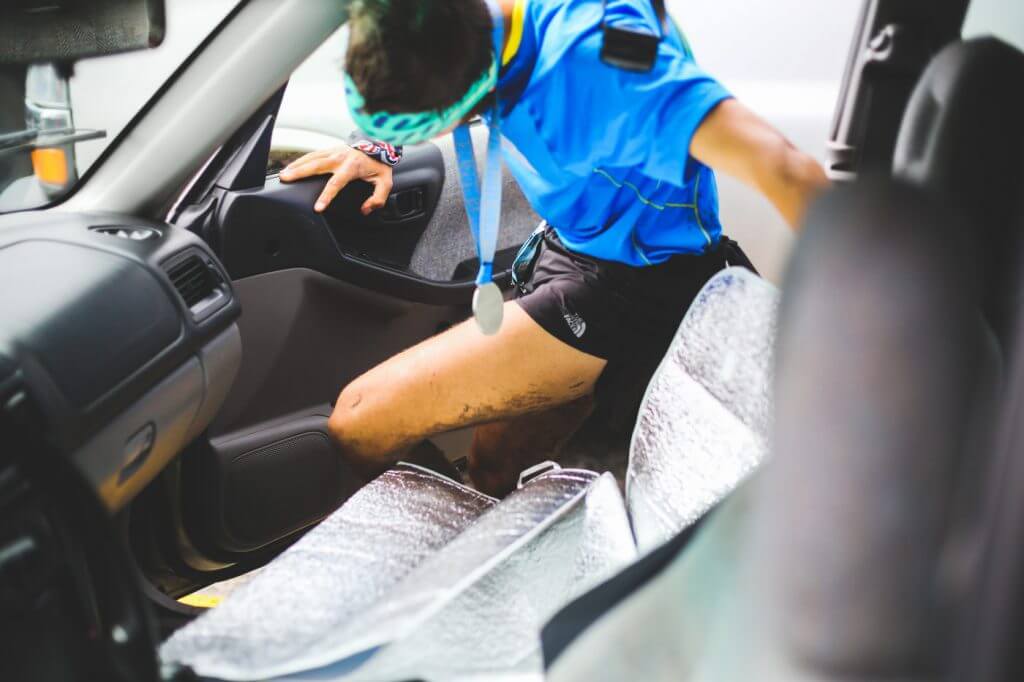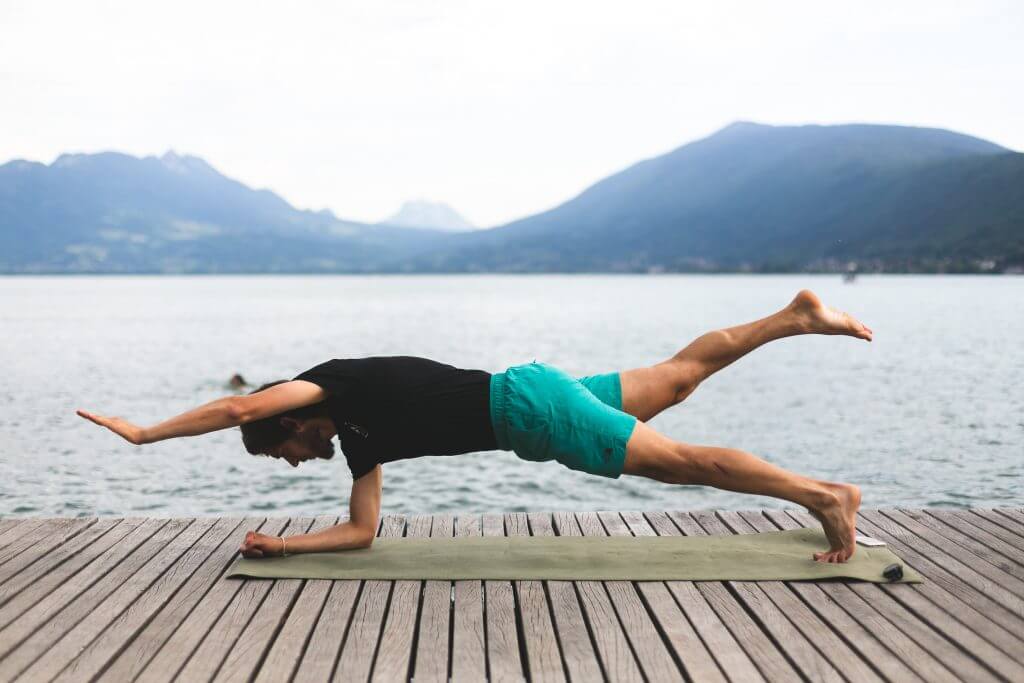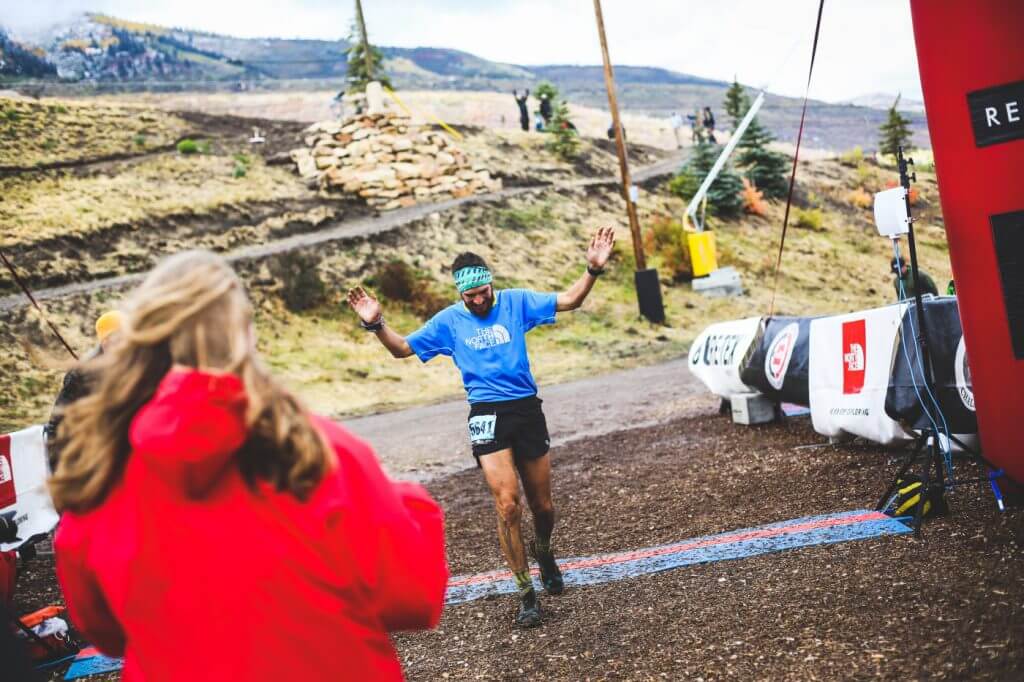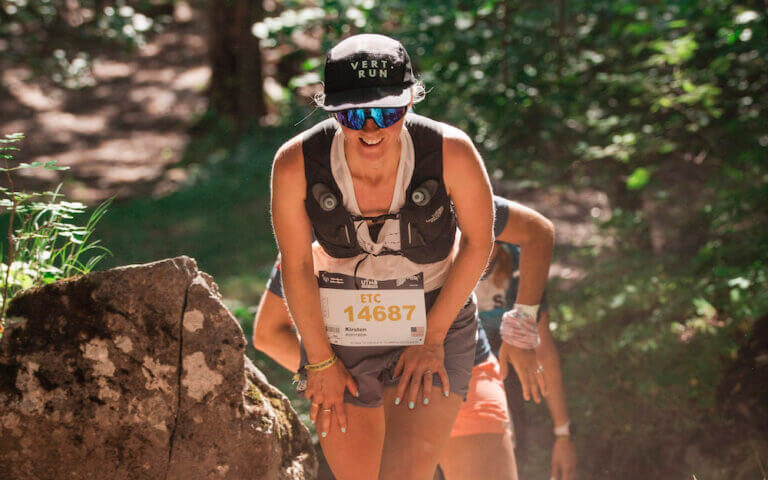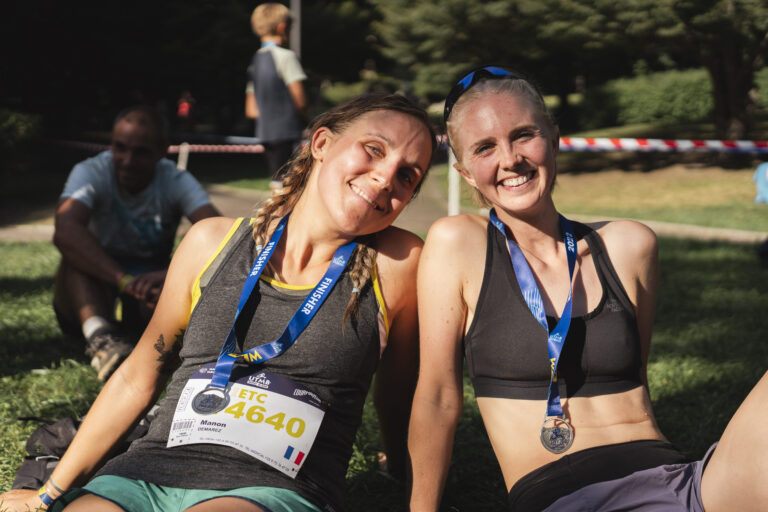In this complete training for a 50k Ultramarathon guide, Moi Jimenez–Vert.run co-founder and professional ultrarunner for The North Face–will guide you each step of the way…from how to choose a race to crossing the finish line.
Why do we run on trails?
If we really think about it, it comes down to one reason: Because trail running and Ultra running are the most simple, easy ways to move trough any type of terrain,
Somehow it’s in our bones–our ancestors had to hunt for their food, and were basically designed to run long distances. Not necessarily to run fast, but to run for hours and move consistently through the mountains, valleys, ad meadows. A 50k race (31 miles) is a great challenge, and is the perfect place to start your ultra-running journey. It’s a big accomplishment, but it’s also attainable.
Yes, it’s hard–but also yes, it’s important–to train and prepare your body with consistency and dedication when training for your first 50k. The more that you want to enjoy the 50k itself, the more well-prepared and consistent you need to be in your training.
Approaching a 50k incrementally is the best, most logical way to prepare.
For example: having a few progressively longer test runs before the race itself is key to being in tune with our fitness and solidifying our confidence. We’ll talk more in-depth about this later in this guide.
Now, the most important question: are you thinking about running a 50k, or are you committed to it? It’s important to respect the distance, and this means respecting your body by preparing it correctly for such a big challenge. It’s a long journey, but we can tell you that your training and race can be two specific things: training for and finishing a 50k is fun, and it’s also incredibly satisfying. Running your first 50k is great for self-confidence: you’ll feel awesome.
How far is 50k, how many miles is a 50k?
The answer is very simple: 50k is equivalent to 31 miles. Now for the harder question: how can a person–specifically, you–run that far? That’s what we’ll answer in this article.
The first step: define your motivation – why do you want to run your first ultramarathon?
What’s driving you to take on the 50k distance?
Everyone has their own drive as to why they decide to train for an ultramarathon. Maybe you’ve run a marathon before? Or another trail race? Maybe the openness of the ultrarunning world is appealing to you? Maybe you want to test yourself and see what you’re capable of doing?
The first step to running your first (or next) 50k is identifying the “why.”
First, you have to put your finger on what’s driving you–find that strong reason, and always keep it in sight as your source of motivation. This is important; it’ll help you throughout the whole process, and will make it easier to get out the door when it feels hard.
The cool part is that it doesn’t matter what your reason is–they’re all valid.
For me, for example, I feel more comfortable in longer races; races between 70 to 100 miles are my sweet spot. But personally, I find that training for a 50k is a difficult undertaking. Why? Since I’m a competitive runner, when I run a 50k I need to be faster and to be able to push and “suffer” at a higher level than what I’m used to. This is tough for me, and especially because a 50k takes around four to six hours. (We’ll talk more about this later, but it’s really important to understand that the time it takes to finish a 50k depends not just on your fitness level, but also on the type of 50k that you choose. A steep, technical 50k will take much longer to finish than a more runnable course will.)
So, back to the topic of motivation. When I decide to run a 50k, my motivation and drive is mostly to get faster, and to take myself totally out of my comfort zone. So, let’s find your motivation, your driving point–what is it for you? In any case, you’ll inspire your family, friends and the people around you and make them really proud…so that’s a starting point, right?
Designing your own adventure.
During the Covid-19 pandemic, most trail races and ultramarathons around the world were cancelled. Now, things have gone more or less back to normal on the race calendar–but the cool thing that Covid-19 taught us is that we don’t always have to have an official “event” or race in order to train for and accomplish something epic.
Plus, if you’re someone who prefers solitude over crowds, doing a long, solo adventure for your first 50k ultramarathon is totally an option and is one that might even be a better fit for you than a traditional race atmosphere.
If you’re considering this route, it’s just important to keep in mind that running 50k by yourself–without other racers, aid stations, or spectators–can be tougher mentally since you have less stimuli around.
If you want to learn more about this, you can read this article about how to plan your own ultrarunning adventure.
(You can also sign up for this Vert.run training plan and tell your Vert.run coach (coaching is included with the plan!) that you want them to help you plan a date, route and time for your first 50k ultramarathon solo adventure and they’ll help you make it happen!)
Want to become an Ultrarunner? We've got the perfect training plan for you!
Which race should you choose?
Now we’ll get into the real stuff. There are so many types of 50 km races. Like, you can choose a totally flat, runnable 50k–or, a slow, super-technical, mountainous 50k. They’re two completely different worlds; for me, actually, the faster and more “runnable” a 50k, the worse. Keeping up the same pace for 50k on a surface that doesn’t change much (like a road or flat trail) is what destroys my muscles the most. Plus, my mind just gets tired of the cadence and of being in “keep the pace” mode. In any case, to each his or her own: you need to choose a 50k that best fits what you like, and what’s around you.
Keep in mind that depending on a race’s terrain or elevation gain, running one 50k can take you 20% to 100% longer than another. For example, I’ve run 50 miles in 7 hours, and also in 16 hours–so, the race terrain really makes a huge difference.
If this is your first 50k, choose a race that’s comfortable for you.
Maybe don’t go “all in” with choosing a far-away race and doing a big overseas trip or picking a race that requires huge logistics to get there. Just keep it simple so that you can focus on the race and the running; for your first 50k, it’s best to focus on this instead of using your energy on logistics, travel plans, finding a way to fly your family there, etc. I know it’s exciting to use your first ultra as an opportunity to travel, but this advice is something I tell to everyone I coach on Vert.run: to be honest, I’d recommend finding the closest 50k to home that you can, and make that race your goal. At the end of the day, chances are that you’ll run another 50k after your first one, and then you’ll run your first 50 miles–so, let’s start simple and safe. Then we can get creative with your next ultras.
Here are some good search tools for finding a race that’s close to you/best fits your schedule:
-Ahotu.
-Itra.
-Ultra signup
The terrain
Like we talked about before, the terrain plays an important role in every mountain trail running race. Depending on which race you choose, you’ll have to study its terrain and elevation profile.
What does that mean? Simple:
What’s an elevation profile? Most simply put, it’s a profile of the up-and-down climbs and descents of the race. So basically, you can have races with lots of small climbs…or, races with one big, even huge climb…or, an elevation profile that’s totally flat. So, of course you can’t prepare yourself for a race with 10,000 feet of elevation gain packed all into one giant climb in the same way you would for a race with the same elevation gain spread out throughout the whole 50k (like, 10 climbs of 1,000 feet each.) They’re all great adventures; whichever race you choose, you’ll have a blast running.
The key to preparing yourself for your race’s terrain is to train in similar conditions and to train for the race’s elevation profile:
If you’ve picked a race that’s close to home, this part will be easy.
So, for example, let’s say that you’ve chosen a race with one huge climb of 10,000 feet. To train correctly for the race’s big climb, you’ll have to train so that by the time the race arrives, you’ve started with smaller climbs and worked your way up to being able to go uphill for all 10,000 feet without having problems.
Another key thing to remember: you’ll need to train your downhill running skills.
Almost everyone who trains for an ultramarathon does lots of uphill running exercises…but forgets to train how to run downhill, especially on technical terrain. During your 50k race, you’ll also have to be able to go back down with the same consistency and strength that took you up the trails in the first place. This is key. Lots of people think that running downhill is the easy part, but it actually takes dedicated training, work and preparation to be able to run downhill–especially in a long race like an ultramarathon. (The good news: all our Vert.run 50k training plans include specific downhill workouts, so you’ll be one step ahead of everyone else come race day.)
Let’s look at another example of how terrain plays a role in your training and race prep: a hilly 50k without any big climbs.
Let’s say that you’ve picked a hilly 50k with four, five or six medium-sized climbs. For this example, the preparation is a little different. You’ll need to prepare yourself to be able to handle multiple inclination changes during the race so that your muscles and mind get adjusted to going up-and-down (and-up-and-down) over and over again. You see? In the first example, you have to prepare yourself to go up for a while, and then down for a while; in the second, it’s more like a roller coaster.
Finally, what if the 50k is mostly flat?
Well, in this case, cadence will be the key. Your goal will be to keep a consistent pace throughout, and ideally to finish stronger than you started. Yeah, sounds a little backwards, right? Is that possible, to be running faster and stronger at the end of the race? It’s possible, and it’s called “negative splits.” The idea with negative splits is to improve your speed throughout the race; for this, training, pacing and a strong mind are key. But don’t worry. You can absolutely do it if you put in the work.
How demanding is the training?
Well, for a 50k race, you should plan to spend between six to nine hours of your week training. If you’re really busy and have to balance family, friends and work, six hours of training per week will be enough. The important part is to use those six hours in the smartest way possible, and to:
Make the most of every training that you do.
A quick note on the importance of consistency: in training for a 50k, there are four workouts per week which are “key,” i.e. they can’t be skipped. Plus, your 50k training plan should be designed to build slowly, steadily and consistently so you’ll be able to handle the race itself. This means that when you complete one week’s training, it gives you the “go ahead” to safely move forward to the next week’s training.
I consider the minimum acceptable training block for a 50k to be a 12-week block.
That means that to run your first 50k, you need to train more or less for three months. Might sound like a lot, right? Well, if we break it down, it’s not that much.
Let’s break those 12 weeks of training down into blocks.
First, it’s about one to two weeks of introduction and activation:This means prepping your body for the full training block.
Then, we move on to two weeks of more specific training, but during which we still train our body to be ready to take on the “real training” that’s coming.
Next, there are around six weeks of specific training. What does specific mean? Well, basically it means doing hill repeats; training specific elements of the race you’ve chosen; working on your jumps routine if you live in a flat place, or don’t have access to the hills every day; and building your core, strength and endurance for the race.
So, each step you take towards race day (by doing long runs; core, strength and jumps work; intensity, speed and fartlek trainings, etc.) is part of a 12-week process. Like we talked about before, each week builds on the previous week’s training, all the way up until that good old’ taper time.
(P.S. If this sounds like a lot to think about, you can always check out our popular 12 week 50k training program called “Become an Ultrarunner.” It’s specifically designed to take the guesswork out of how to prepare you for your first ultramarathon.)
Finally, your 12-week training block should finish with a taper.
Tapering is the time before your race where you rest, recover and allow your body to get “fresh” for race day. The taper is the moment when you can look back and see all the work that you’ve done: all those miles; early morning runs; mountain days with friends, or by yourself; all those intensity trainings when the time went really, really slow during every repeat; those mornings or nights doing loops in your neighborhood, or running up and down the only hill around, feeling like the only person in the city spending their free time running like a hamster…the taper is your time to look back, reflect, and be proud of yourself for your whole training process. It’s all worth it.
So. After those 12 weeks of training, you’ll finally hit the moment when it’s time to taper. During your taper, you’ll reduce your training to 70-75% of your normal volume two weeks before the race, and to about 20-40 % during race week. Sometimes, it’s even better just to rest and go for a couple of easy jogs during race week, so that you can arrive completely fresh and motivated.
50k & Ultramarathon Training schedule.
In the last section, we touched on the different blocks you should break your 50k training schedule down into. Here’s a more detailed breakdown of these four blocks for you:
Block 1: the “introduction” period.
This block should last for two to four weeks. If you’ve never run on trails before, or if you’re relatively new to running, this block can be up to four to five weeks. The goal is to prepare yourself to enjoy and complete the training that’s coming ahead. This block is meant to be simple; for example, maybe you’ll run three to four times per week at an easy pace; your runs can range from 30 minutes to one hours during the week. On the weekend, your runs can be longer, but taken equally as easy. This period shouldn’t be extreme; even going for a long hike on the weekends is good training. The important thing is to be consistent. Keep yourself moving, keep getting out even on those days when it feels hard. This consistency will set your attitude and spirit for the rest of the training process.
Block 2: the “basic” period.
Block 2 is the complement to the introduction period; it also lasts two to four weeks, and brings with it the introduction of strength, core and jumps routines. During this block, you’re building the base of your fitness for your 50k, and believe it or not, building this base isn’t done only by running. Having a strong core will give you stability, and will protect your back from getting injured. All the pounding our bodies take when we run impacts each person different, and this is also why having a strong core is crucial.
Strength for trail & Ultra runners:
Is also a key part of your 50k training. If your body isn’t used to the load of training that you’ll undertake throughout your race prep, you have to prepare it. The most efficient way to do this is by completing a strength routine one to two times a week–every week. (Here you can check out the strength routine that we schedule into all of our Vert.run 50k training plans.)
During Block 2, your runs will be similar to those you did during the introduction period–but you should also be adding some key “activation” workouts.
Strides for Trail & Ultra runners:
For example, are the best way to get your body to feel active and sharp, and to test yourself under some speed and intensity for short periods of time. (Check out our Stride Guide here for some helpful tips about how to run a stride.)
Block 3: the “specific” period.
Here’s where things get a little more serious. Now, it’s time to do all those workouts that will build your preparation for the race itself.
In Block 3, hill repeats are key. To give a small example: you could start by doing three sets of three 15-second hill repeats on a hill with a 15% gradient. Then, week by week, you build yourself until you’re doing three, then four, then ten minutes of hill repeats–and, sometimes mixing the repeats with flat speedwork.
A quick note here: it’s really tough to write just one “guide” for this phase of the training process–especially because depending on your experience, if you have regular access to trails to train, the terrain of your 50k–everyone’s training should look a little different. That’s why we have our Vert.run 50k training plans on our training platform–they’re designed by professional ultrarunners, and they auto-adapt by pulling from a pool of over 500 workouts to fit your athlete profile. Plus, they include weekly coaching from your personal Vert.run coach…and it costs $6 USD / week. (We know this is a really great price–we work really hard to make high-quality training plans available at a price point that works for everyone. That’s why we started Vert.run, actually.)
In general, this third block–the “specific” phase–is the core of your 50k prep. So, be aware that it can feel like it lasts forever, and that you’ll feel tired sometimes. That’s why it’s important to have a recovery protocol in place. I recommend adopting a 3×1 or 2×1 recovery week protocol. This means that you train for 2-3 weeks (doing the key workouts, long runs, strength training, core work, etc.) and then take one week where you reduce your training to 60-70%. You’ll do this by cutting down on intensity trainings and long runs, which will allow your body to recover and heal before the next set of weeks. Recovering is as important as training, so take it seriously.
Block 4: the “taper” period.
This is the time to look back, see all the work you’ve done and to feel confident for your race. If you’re reading this, you’re probably still far enough out from your race that you’ve got a good amount of time; this means that all you’ve got to do is to follow your training consistently. To tell you the truth, the only secret to running and enjoying a 50k is to complete your trainings consistently, day in and day out. Personally, I don’t know another or faster way to do it. During your taper, you’ll focus on resting, sleeping, stretching, and eating. Be sure to listen to your body during your taper; if you feel like sleeping in an extra 30 minutes or an hour instead of training, DO IT! Yeah, you’re allowed–but only because you’ve already done all the work. There’s nothing worse than arriving to the taper without having done the work and feeling unprepared, and if you’ve done the work, you’ll feel the opposite.
Here’s how your hourly volume of training should increase week after week.
This example is from our popular “50k: Become an Ultrarunner” training program.
This is how your long runs should increase over a 12-week training plan for a 50k.
This example is from our popular “50k: Become an Ultrarunner” training program.
The next step: set your 50k or Ultrarunning race goal.
Setting a clear, reasonable goal for your race will form the foundation of your training and give you a base to work from. Why? It’s pretty simple. I recommend that you set an achievable goal for the race–and that you set it in terms of how long, in hours and minutes, you want to run the race.
Never set “finishing in x place” as your goal.
Because you can’t control how the rest of the runners will run that day–why would you set a goal for yourself that depends on how other people perform? On the other hand, your own race time is something that you can control and train for. To do this, ask yourself how long you think that it should take you to run the whole course. This will depend on the race’s profile, terrain, and race-day conditions–but you can always estimate. Let’s say you set your goal as being to break 7 hours. It’s not a bad goal: during my first 50k, I was out for about 7.5 hours.
With the 7 hours mark in mind, now you can do some math and define your training based on that goal. One important key for a 50k is that if your goal is to run in 7 hours, you should train between 20-30% more than that per week. This means that if you’re aiming to finish your 50k in 7 hours, you should train between 8-9 hours per week in order to feel comfortable running 7 hours in one push during the race itself.
It’s not all about running: core, strength and stability exercises are key for Trail & Ultra runners.
You’re going to run a 50k. So, you might think that the only thing you need to do in order to arrive to the race in good fitness is…to run. That’s not the case. You have to–and this is important, so I repeat–you have to designate about 15 to 20% of your training time to build the strength in your core, legs and back. The main reason for this is to prevent injury throughout your training and the race, but there are countless other benefits. These exercises will make you stronger, faster, more stable and give you consistency in your training.
- Key routine #1: A Core Routine for trail runners:
Even though at-home exercises aren’t as fun as running down a mountain, you can’t do the latter without first dedicating yourself to the former.
A good core routine builds strength in our upper body (our “core.”) This strength keeps our bodies aligned, which helps us maintain good posture while running. Good running posture = more control = safely cruising those downhills we talked about.
A core routine is a vital component of your training routine as a trail runner. Running higher, running farther, running faster: these are all great things, but if you want to get there, you have to put in the off-trail work. It’s important to prepare our bodies to safely withstand the impact they take while running downhill; to move uphill with power during long trainings and races; and to keep us strong during all distances.
When you do these core exercises—not rushed, but with effort and focus—you’re building a longer athletic life and preventing common trail running injuries.
At Vert.run, we designed a series of routines for each type of exercise. So, here’s where you can find all of our most popular core and strength routines for trail and ultrarunners.
The point of doing strength exercises isn’t to look good: it’s to prepare ourselves to run efficiently and reduce our risk of injury.
A strength routine plays a key role in your development as a trail runner. We need to prepare our bodies to withstand the impact of running long downhills; to avoid fatigue (and thus avoid falling) in technical sections; and to be a strong, compact ally to our minds during climbs.
Our strength routine gives you resistance and endurance during your races and long trainings, no matter the distance. That’s why we schedule it into all of our trail running training plans.
- Key routine #3: A Jumps Routine for Trail Runners:
A jumps routine is a vital part of trail running training—especially if you don’t have daily access to the mountains or trails. Jumps exercises aren’t a replacement for training in the mountains, but they sure are a good way to prepare ourselves for them.
When done correctly and methodically, a jumps routine will help you feel stronger and more prepared when heading to the mountains to train or race.
Our routine aims to train two things: your strength and your competence in different types of terrain. These skills safely enable you to run farther and more consistently in the mountains.
Here you can find our Jumps routine.
The keys to executing these strength and Core routines:
- Always do your core, strength or jumps routine on a day with a moderate to easy run. (Before or after your run is fine, whichever you prefer.) Don’t mix core exercises with an intense training or long run. If you’re too tired, you won’t have the strength to do the exercises correctly.
- Quality > quantity. Don’t be shy about cutting the number of repetitions. It’s way better to do fewer repeats, but to do them with control. Then, you can keep building from there.
- You should do these exercises at least once a week (but don’t exceed three times per week.) In order to build strength, consistency is key. You need to have weekly contact with your routines—that’s why we always put them in our Vert.run trail running training plans.
Measure your training in time–not in miles.
Throughout the years, I’ve realized that so many people measure their training in miles. I’m not about this; I think that it’s best to measure in time, instead. For me, measuring my training in miles ends up being so stressful. Like in my case, right now, I’m training for a 100 mile race. Imagine that for my race prep, I have a long training of 50k on a particular Saturday. Waking up on Saturday morning and thinking “…I have to go run 50k today” won’t feel motivating. Or do-able. At all. That’s why I recommend measuring your training in time (hours and minutes) instead of in distance.
First of all, you’re the one who’s in charge of your time–so this way, you can put your training into your schedule wherever it fits best. (Also with Vert.run, you can swap your workouts of your 50k training program in the app so they better fir your schedule!)
By knowing how long you have to train, you can fit your workout into your lunch hour, or before work, or between eating dinner and putting your kids to bed, etc. Measuring in time instead of in miles allows you to better manage your schedule. For example, let’s imagine that today, you have to do a “10 mile run.” But today, for whatever reason, you don’t feel good. Let’s say that running 10 miles in the hills usually takes you two hours, but today, it takes you 2.5. This means one of two things: either you end up cutting the training short and feel bad about “not finishing,” or you’re late for whatever you have scheduled after the run.
On the other hand, if you don’t think about the miles and instead approach your training as being a “two hour run,” awesome things can happen. You’ll feel a sense of satisfaction in completing the run time. Sometimes, if you feel amazing, maybe you run even farther than ten miles that day. You get the point.
By focusing on time instead of distance, you’ll have more freedom. You’ll be able to complete your training blocks and feel the resulting confidence, and won’t leave workouts half-done.
So, you know your distance (50k) and your goal (to finish the race in under 7 hours). Now, you can define the duration of your workouts and the average number of hours that you’ll train each week in preparation for the race.
Here’s what I recommend as a general training program–in hours–for the 12 weeks of prep. Without thinking yet about each workout, we already know how much we’ll be running each week…and thus, how much we’ll be running each day.
How you should feel during a 50k or Ultramarathon training process.
During your training, you’ll of course feel tired at times–but there are certain things that are not ok. So when you feel something weird or unfamiliar in your body, it’s always better to put on the brakes and rest a little more.
Feeling training fatigue is pretty common. This includes things like tired legs going up and down the stairs (always take the stairs, it’s part of your training now), or feeling sore legs when you wake up in the morning. These feelings are okay and normal to feel; just remember to do your foam rolling sessions and your stretching exercises a few times per week
What if you start to lose your appetite?
This, for example, is not normal or okay. You should feel hunger in proportion to your training volume; when you have a big training, you’ll probably feel more hungry, and vice versa. But it’s important to note and monitor your hunger levels on a weekly basis. Everybody’s body is different–for me, for example, I know that my “big” hunger levels actually hit on my rest days, not on the day of my long runs themselves. But, I’m familiar with my body and hunger levels, and I make sure to eat during the day until I’m no longer hungry. The key is to eat well, balanced, and healthy.
Another feeling to watch out for is for sharp pain in specific places in your legs, especially when the pain appears in tandem with specific movements. This is “no bueno,” as I like to say. Sharp pain is never a good thing (e.g. pain that feels like a needle in a ligament or joint) because it’s often a sign that injury is either on its way or has already arrived…so, make sure to pay attention to your feelings, and identify if you’re feeling this type of pain.
Knee pain for Trail & Ultra runners.
Why do so many trail and ultrarunners suffer from knee pain? Because the knee receives a big part of the impact when we run–but when we feel knee pain, the reason is not the knee, and the problem almost never originates in the knee itself. That’s why it’s so important to do your core and strength exercises regularly. If you have pain in your knee, first: stop running. Then, it’s safe to assume that that the problem or weakness is probably is in your glutes, quadriceps or IT band, so stop running and go to a specialist to find the source of pain and fix the problem.
Remember that you must enjoy the training so if you’re losing motivation and not enjoying the process, take a week off, no worries, give yourself time to recover your body and mind and you will be back stronger and motivated to continue the training for your next 50 km. You’re doing this for yourself and for your own reasons so if you’re not enjoin it, what’s the point? of course this doesn’t mean that if one day you don’t want to do your training the best is to stay at home, but if you find yourself 2 weeks in to a “not having fun” mood, then you can take some time off.
Taper and recovery for an Ultramarathon.
When all the work is done, it’s time to recover and to respect yourself for all the prep work you’ve done. Always keep in mind that even if the race day goes horribly or differently than you’d hoped, that you’ve done all of this incredibly tough physical and mental work and had all those adventurous days out. Nobody can take that away from you, so make sure that you enjoy the preparation process, because your enjoyment is what matters in the end.
For tapering, I recommend doing so for two weeks. You won’t lose fitness, and you’ll gain both energy and time.
The first week of tapering for a trail race or an Ultramarathon:
Should be a volume of about 70 to 75% of your normal training. So, if you train 9 hours per week, feel free to train between 6 and 7 hours during your first taper week. If you feel really tired, you can go down to 4 hours–this might also help you to recover better if it’s what your body is asking for. Different people need different tapers, but it’s really important to keep in mind that rest and recovery is part of the training. It’s way better to arrive to your race 20% under- trained than to arrive 1% over-trained. Believe me, in the latter case, you’ll definitely feel the brunt of that 1% on race day.
Your second week of tapering:
should be between 20-40% of your normal training, so in the example of a 9-hour training week, you’d cut down to 2-3 hours max. And, divide these hours into short runs.
An ideal taper week for a Saturday race day would be:
- Monday: rest day
- Tuesday: 30 to 45 minutes easy run + 4-6 strides of 20 seconds each at 80% of your max speed
- Wednesday: rest day
- Thursday: 30 to 45 minutes easy run
- Friday: 20 to 40 minutes easy run + 3 strides of 10 seconds each, or full rest
- Saturday: Race day
(Want to take the guesswork out of training for your first 50k Ultramarathon? Try our popular 12 week 50k training plan “Become an Ultrarunner” and let us take on the logistics so that you can focus on the part that matters most–enjoying the trails.)
Tapering is not a magic wand, but it is important. Plus, now that you’re training less, you’ll find yourself with so much free time. What will you do with all this time on your hands, if you don’t plan in advance? You’ll probably feel worried about the race, so it’s good to take advantage of all this free time to deal with race logistics, enjoy your extra time with family and friends, and–most importantly–sleep, sleep and more sleep. Sleep in, sleep early, sleep as much as you can.
Food and fueling for an Ultramarathon.
Check out our Nutrition guide for Ultra runners designed by our friends at On Pace Wellness.
While counting calories may seem like a thing of the 90’s, having a general idea of how much food you should be taking in while training is probably a good idea. This can help prevent under-eating (or under-fueling) during your training program.
Read our article about Keto diets and Ultramarathons:
“Can you run an Ultramarathon on a ketogenic diet”
By no means do we endorse (or not endorse!) a diet–each person has different needs, and a different diet that works for them. But’s cool to see what things and options are out there. Here’s some info from our latest article about keto diets and Ultrarunning:
Is a Ketogenic diet a competitive advantage or disadvantage for Ultramarathons?
That’s a hard question and there’s not one answer fits all here. Of course, some athletes do amazingly well on ketogenic diets and others on non-ketogenic diets, like we mentioned at the beginning. There is no miracle when talking about diets.
If you see it from an adaptation point of view, it can be a huge disadvantage. Imagine you’re in the middle of an Ultramarathon and you run out of your keto products and have carbs available to fuel yourself. Your whole thing will just not work. What would you do then? Based on experience, you should be able to be adaptable and to perform using whatever is available, so actually if you’re very efficient using fat as fuel and carbs as fuel you’ll have all the advantages and you will probably be a stronger runner.
So technically we can’t say being on a keto diet will give you a clear advantage from people who are not, but definitely being more fat adapted can be helpful in an Ultra.
Your Ultramarathon race day.
It’s time to toe the start line: but don’t worry, you’ve done all the work, and now it’s time to enjoy it.
It’s normal to feel nervous before the race–no matter how many times we’ve raced, almost all of us feel some type of anxiety beforehand. That’s why we wrote a specific article about this.
“We’ve all been there: it’s the night before a race, and your brain will. Not. Let. You. Sleep. Maybe it’s your first race (or your fiftieth) and you’re feeling wired–but not in the good way. Your nerves just won’t let you sleep. I myself have had so many of these nights before important races: my body (or, my anxious brain, I guess) wakes me up at 2:00 am, or maybe 4:00 am, and refuses to let me get any more precious shut-eye. So, I toe the starting line with just a couple of hours of sleep under my belt.
Check out our “how to calm race-day nerves” article for some more in-depth discussion about keeping cool before your race.
I have to be honest, running your first 50k isn’t easy to put all into one article. There are so many more things that we could keep digging into–we didn’t even touch anything about nutrition, race fueling, stretching or foam rolling…so, I’m sure there will be more to come in a future article. For now, I hope this has been helpful. If you have any questions or suggestions, please don’t be shy. Write us at team@vert.run; we’re always happy to chat.
We wish you the best of luck on your first 50k, and who knows? Maybe we’ll run into each other, either at this race or the next.
P.S. Of course we’re biased, but we really think that our “Become an Ultrarunner” 50k training plan is the best tool out there for anyone who wants to unlock the title of ultrarunner. Try it out today and see why 100s of trail runners have crossed their first ultra finish line by training with Vert.run.

